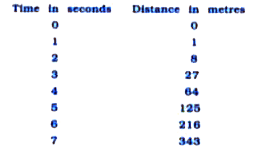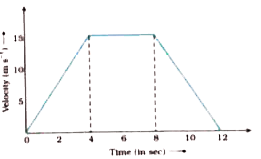A force of 5 N gives a mass m1 , an acceleration of 10 ms−2? and a mass m2, an acceleration of 20 ms−2? What acceleration would it give if both the masses were tied together?Solution in Gujrati
m1=Fa1 and m2=Fa2
Here , a1=10ms−2,a2=20ms−2 and F=5N
Thus ,m1=5N10ms−2 =0.50 kg and
m2=5N20ms−1 =0.25Kg
If the two masses were tied together ,the total mass,m would be
a=Fm=5N0.75kg=6.67ms−2
Topper's Solved these Questions
- BOOK - KUMAR PRAKASHANCHAPTER - FORCE AND LAWS OF MOTIONEXERCISE - Additional solved numericals9videos
FORCE AND LAWS OF MOTION
- BOOK - KUMAR PRAKASHANCHAPTER - FORCE AND LAWS OF MOTIONEXERCISE - Additional Exercise4videos
FORCE AND LAWS OF MOTION
- BOOK - KUMAR PRAKASHANCHAPTER - FORCE AND LAWS OF MOTIONEXERCISE - QUESTIONS AND ANSWERS(Answer the following questions in detail:)4videos
FORCE AND LAWS OF MOTION
- BOOK - KUMAR PRAKASHANCHAPTER - GRAVITATIONEXERCISE - ACTIVITY 10.42videos
GRAVITATION
Similar Questions
A truck starts from rest and rolls down a hill with a constant acceleration .It travels a distance of 400 m in 20 ms.Find its acceleration 6 tones (Hint:1 tonne =1000 kg)
04:47View SolutionThe following is the distance-time table of an object in motion:

(a)What conclusion can you draw about the acceleration ?Is it constant. Increasing decreasing ir zero? (b)What do you infer about the force acting on the object?02:52View Solution(a)Define :Force
(b)The velocity -time graph of a car of mass 1000 kg is given below:
(i)When is the maximum force acting on the car>Why?
(ii)What is the retarding force?04:53View SolutionTake an empty plastic bottle . Close the mouth of the bottle with an airtight stopper . Put it in a bucket filled with watere . The bottle floats .
Push the bottle into the water. You feel an upward push. Try to push it further down. You will find it difficult to push deeper and deeper. Water exerts a force on the bottle in upward direction. Now release the bottle. It bounces back to the surface.
Does the force due to the gravitational attraction of the earth act on this bottle? If so, why doesn't the bottle stay immersed in water after it is released ?03:33View SolutionDerive the unit of force using the second law of motion. A force of 5N produces an acceleration of 8ms−2 on a mass m1 and an acceleration of 24ms−2 on a mass m2. What acceleration would the same force provide if both the masses are tied together?
04:35View SolutionA force of 2N gives a mass m1 an acceleration of 5m/s2 and a mass m2 an acceleration of 7m/s2. What acceleration would be produced if both the masses are tied together?
02:13View Solution5 न्यूटन का बल लगाने पर ,m1 द्रव्यमान के पिण्ड में 10m/s2तथाm2 द्रव्यमान के पिण्ड में 20 m/s2 का त्वरण उत्पन्न होता है | यदि दोनों पिण्डों को एक - साथ जोड़ दिया जाये तो त्वरण कितना होगा ?
04:20View Solution10 न्यूटन का एक बल दो द्रव्यमानों m1व m2 को क्रमशः 20 मीटर/सेकण्ड व 30 मीटर/सेकण्ड का त्वरण देता है | यदि दोनों द्र्व्यमानो को एक साथ संयुक्त कर दिया तो इस बल के द्वारा उत्पन्न त्वरण की गणना कीजिए |
View SolutionA force of 5 N gives a mass m_(1) an acceleration of 8m//s^(2) and a mass m_(2) an accleration of 24 m//s^(2) . What acceleration would it give if both the masses are tied together?
03:09View SolutionWhen a force F is applied to a mass m1, its acceleration is 6 m/s2. If the same force is applied to another mass m2, it gives an acceleration 3 m/s2. If the two masses are tied together and if the same force is applied to the combination it gives an acceleration
03:18View SolutionA constant force of 5 N can produce an acceleration of 1 m/s2 on the body of mass m1 and 2m/s2 on the body of mass m2 . If both the masses are tied together and same force is applied then what will be the acceleration of the system ?
04:25View SolutionA force of 100 N gives a mass m1, an acceleration of 10"ms"^(-2) "and of 20ms"^(-2) to a mass m^2. What acceleration must be given to it if both the masses are tied together ?
02:31View Solution5 N का एक बल किसी द्रव्यमान m1 को 10ms−2 का त्वरण देता है तथा द्रव्यमान m2 को 20ms−2 का त्वरण देता है। अगर दोनों द्रव्यमान को एक साथ मिला दिया जाए तो इस बल के द्वारा क्या त्वरण उत्पन्न होगा?
03:00View SolutionA force of 100 N gives a mass m1, an acceleration of 10 ms-2 and of 20ms−2 to a mass m2. What acceleration must be given to it if both the masses are tied together?
03:04View SolutionDerive the unit of force using the second law of motion. A force of 5N produces an acceleration of 8ms−2 on a mass m1 and an acceleration of 24ms−2 on a mass m2. What acceleration would the same force provide if both the masses are tied together?
02:07View Solutionगति के दूसरे नियम का उपयोग करके बल का मात्रक व्युत्पन्न कीजिए। 5 N का कोई बल द्रव्यमान m1, पर कार्य करके उसमें 8ms−2 का त्वरण तथा द्रव्यमान m2 पर कार्य करके उसमें 24ms−2 का त्वरण उत्पन्न करता है। यदि दोनों द्रव्यमानों को बाँध दें, तो यही बल कितना त्वरण उत्पन्न करेगा?
02:09View Solution

